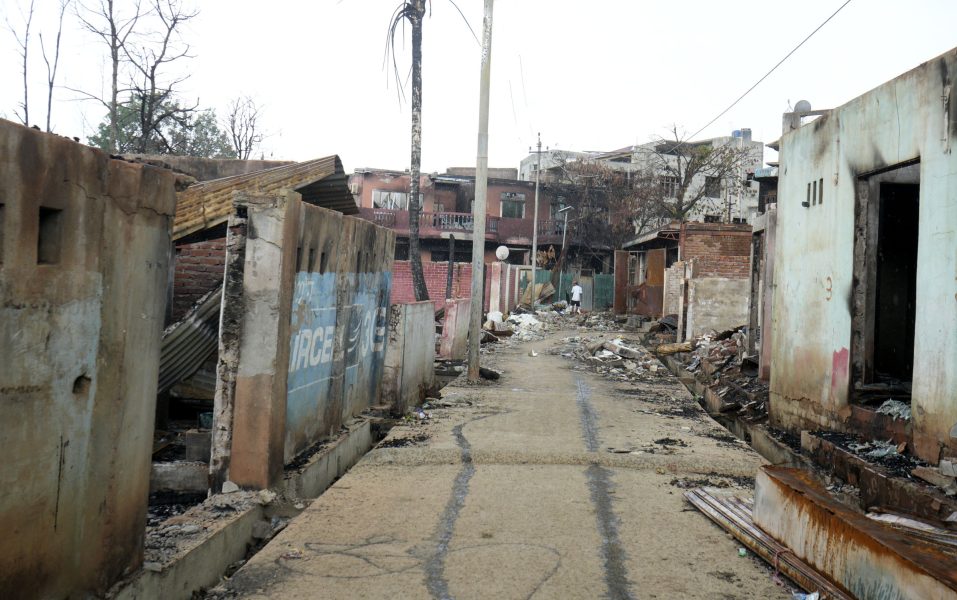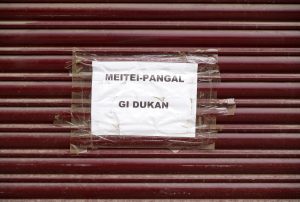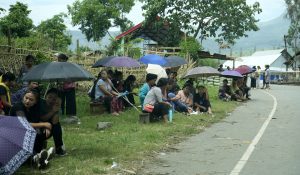
Ground report: Peace and normalcy a far cry in violence-battered Manipur

‘Meitei Pangal Gi Dukan’ (This shop is owned by a Meitei Muslim), proclaims a paper taped to the shutter of a shop beside the charred remains of another at a mixed locality in Imphal.
Meitei store, Bihari hotel, Meitei yum (home) are similar identification marks put up on rows of shops and houses belonging to the non-Kuki communities to avert their properties meeting the same fate as that of the one burned down by a mob a few weeks ago.
These identity markers are among various tell-tale signs of disquiet scattered across Manipur that belie the façade of normalcy being put up by vehicles darting the state capital Imphal; gradual reopening of shops and offices and Imas (mothers) of the state’s iconic Ima market returning reopen their stalls – that is when the curfew is relaxed from 5 am to 8 pm.

To put up even this semblance of basic normalcy is proving to be a challenge.
Many of the vehicles plying on the streets are run on overpriced fuel bought in “black” from roadside vendors selling petrol in bottles of mineral water. For a litre, they charge anything between ₹130 and ₹150. The price for the same in petrol pumps was ₹101 on Sunday (June 11).
Black market
The price of petrol had shot up to ₹180 last month when there was acute shortage. It is still short in supply, particularly outside the city, inducing illegal trade.
The administration too is run on contingency measures as the scarcity hit the state Secretariat as well.
Many Kuki officials, the backbone of Manipur’s top bureaucracy, have either gone on leave or deputation, creating shortage of senior officials, a senior government functionary close to Chief Minister Biren Singh told The Federal.
Also read: Meiteis of Tripura appeal for peace in Manipur
The exodus is another pointer to the depth of the festering ethnic divide in Manipur, literally meaning jewelled land.
Faced with the shortage, the state government moved the Centre, seeking officials to be posted on emergency deployment.
“Five directors are being rushed from the Central secretariat in New Delhi to fill the gap. Three of them have already joined. Many non-Kuki IAS and IPS officials of the state cadres, who are on deputations, have also been asked to come back,” he added.
Administrative changes
Earlier this month, the Manipur government roped in an Indian Police Service (IPS) officer of the Tripura cadre, Rajiv Singh, as new director general of police (DGP) replacing P Doungel, a Manipur-cadre IPS officer belonging to Kuki community.
Doungel’s transfer to an inconsequential post termed officer-on-special-duty, created in the Home department, is not without its own significance.
Footfalls in the shops including those in the Ima market that has resumed business are very less.
“Our business has been reduced to almost naught. There are hardly any customers,” said a lady running an eatery joint at Mahabali Road, Imphal’s fast food hub.
Shops in and around the Tribal Market and many other localities inhabited mostly by people from Kuki community continue to shut down almost a month after the ethnic clashes gripped the state on May 3.
“Our shop has been closed for over a month now. There is no certainty as to when we can resume business again. My family of four is surviving gnawing at whatever little savings I had,” said Lalan Prasad, a clothing store owner at New Checkon, near the Tribal Market.
Divided Manipur
Ravaged Kuki localities are mostly empty as their inhabitants fled to “secure” places, leaving behind their charred or vandalised houses, religious places, business establishments and other movable and immovable properties.
These horrific trails of destruction in the capital city are at worst just the remnants of one of the most disastrous ethnic strifes witnessed by Manipur, a state which is no stranger to conflicts.
Similar scenes of destruction can be seen in the Meitei localities and villages in Kuki-dominated areas as well.
Over 100 people were killed, thousands injured and more than 50,000 people have been displaced from their homes as per government statistics.
The enormity of the crisis, however, cannot be measured by these numbers as they do not reveal the schism the unrest has created between the Meitei and Kuki communities, who generally have lived peacefully side by side for centuries.
As per the accounts of British administrator CA Soppit, the presence of the Kuki community that comprises more than 25 sub-tribes was first found mentioned in Manipur in the 16th century.
Divided worlds
The mixed demographic profile, however, took a severe beating post May-3 violence as it has led to complete ghettoization with no Kukis to be found in Meitei areas and vice versa.
Meiteis live mostly in the state’s valley districts while Kuki population are concentrated mainly in the four hill districts.
Kuki-dominated hill districts are now virtually out of bound for Meiteis. Likewise, Kukis feel they can no longer settle in valleys and seek a separate administration for themselves.
The “ghettoized zones” emerging from the unrest are fiercely guarded by civic volunteers, mostly women, from the respective communities.
Also read: 35 weapons, warlike stores recovered by security forces during combing operations in Manipur
Vehicles coming from the Meitei-dominated valley are frisked by Kuki volunteers before allowing them entry into their “territories.” Similarly, those coming from the hills are allowed to proceed to the valley only after the volunteers are satisfied with the antecedent of visitors.
The Federal team came across many such “checkposts” on its way to Churachandpur, Tengnoupal and Kakching districts.
“We are keeping the vigil for 24 hours because Kuki militants continue to attack our villages. We want to be in our homes, but we are forced to be on the streets because of them (Kuki militants),” said Rashi Devi, a member of Kakching unit of the Meira Paibai, the powerful women civil society group often referred to as “torch bearer” of Meitei civil society.

Passions run high
Similar apprehensions are expressed by volunteers of the Indigenous Tribal Leaders Forum (ITLF).
“We need to defend our land because the majoritarian state government of Manipur is eyeing our territory,” an ITLF spokesperson, Gracy, said off the camera.
Clearly people on either side of the divide have lost faith in the government’s ability to protect them.
This led to civilians taking law into their hands even to the extent of taking up arms.
Agitated mobs have “snatched” from police over 4,000 arms, many bombs and thousands of rounds of ammunition. Of them, around 700 arms were looted from police armouries in the hills, according to a government estimate.
A total of 990 arms and 13,526 ammunition were voluntarily deposited to the government while a combing operation launched by the security forces led to the recovery of another 53 arms, 74 ammunition and 39 bombs, information and public relation minister S Ranjan Singh disclosed on Saturday.
Missing weapons
Over 90 per cent arms are still with the civilians.
Many of those who did not have the luxury of wielding sophisticated weapons snatched from government armouries are making improvised weapons to what they call “defend our villages”.
Unauthorised firearms in civilian hands assume greater threat due to presence of several militant outfits in the state.
“If these arms are not recovered it will come to haunt us back in future. These may fall in the hands of militants,” a Manipur-minister said, wishing anonymity.
Poor recovery rate of arms is an indication of the prevailing mood in the state and the government’s haplessness to act firmly.
With both sides digging their heels and the governments both at the Centre and the state seem to be in a wait-and-watch mode, peace and normalcy appears to be a far cry in the trouble-torn state.
Also read: Kharge slams PM for his stoic silence on Manipur, terms it a betrayal
Union Home Minister Amit Shah’s assurance on May 31 to address the present crisis within 10 days has found no resonance on ground.
Shah had given the assurance while addressing the media at the end of his three-day tour he made to the state almost 26 days after the violence broke out.
“It will take at least five years for the ethnic fault lines to bridge,” claimed a valley-based legislator.


